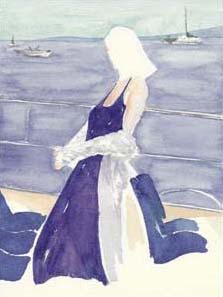| |
 |
Charmeuse is "satiny smooth". It may be a light or medium weight fabric woven with a satin weave, where the top threads cross over three or more of the backing threads. The front side of the fabric has a satin finish, with a lustrous sheen, whereas the back has none. Charmeuse is softer and lighter in weight than satin, and drapes beautifully. My painted work allows you to have a reversible piece. Bolder, with glisten on one side, and softer, more muted and sheenless on the other, one Charmeuse scarf works with several wardrobe pieces. The weightier Charmeuse I work on has a marvelously sumptuous feel.
Some of the Charmeuse I select is light and feels as sheer as breath. The other is like satin, the weightier drape of which is flattering. Both are top of the line, and a scarf is wide enough and long enough to drape as a wrap. A wrap which helps you be warm! Its luster and delicate hand make Charmeuse suited to lingerie, flowing gowns, and drape blouses. Bridal gowns sometime use Charmeuse. The silk drapes in a way which enhances the body, and is perfectly suited to fluid garments such as shawls, scarves, and chemise.
|
For about twenty-five centuries the history of silk belonged to China, until only a few hundred years B. C. These riches became exposed to the world via the Silk Road. Having control of the trade kept China in a primary place with regard to silk for another thousand years.
Silk was used as a medium for calligraphy and art, as well as for several other applications. Silk and color were inextricably tied as emblem of social status in the Tang Dynasty.
Japan undertook silkworm cultivation around 300 AD, and by the 500's, the Byzantines and Arabs began in silkworm cultivation as well. Sericulture on the rise, Chinese silk exports suffered a drop, but the luxury silk market was still China's. Italian states, once exposed to the fine fabric and its sources during the Crusades, took to exporting silks to the rest of Europe and prospered greatly. In the Middle Ages spinning wheel first appeared, and processes were redeveloped. France took on the silk trade successfully.
Cotton, along with the Industrial Revolution's ideas for spinning it, took attention from Europe's silk industry. Cotton fabric was economical to produce. The Jacquard loom came along for silk embroidery, however, and along with new, streamlined methods of production, silks kept on going. Silkworm diseases then struck, and hurt the industry in France irrevocably. Japan and China took center stage again in the 20th century. China is again the world's largest producer of silk today. Silk is a luxury good, as ever, now richer than ever. We enjoy access to fine quality available today.
Recently I learned that silk was vital to the making of escape route maps during World War II. I can tell you more if you’re interested—email me. I’ll include the story one day on our Facebook Pages.
|
Crepe is woven of silk thread in its natural condition. There are two distinct varieties of the fabric: soft, Cantonese crepe and hard, or crisped crepe. Thin crêpe is called Crêpe de Chine. Crepe may have a gauzy texture, and may also have a somewhat crisp or crimped appearance.
The sometimes wavy appearance of Crepe de Chine results from a different method of crossweaving. The silk thread from two sources twist together in a kind of reverse way. The fabric is sometimes smooth and even, having no crepe appearance. The fabric structure is what constitutes its distinguishing feature. Crepe de Chine is used for scarves and shawls, and the kind I use is smooth and well able to receive my brushed-on color.
The crisp and elastic structure of hard crepe emerged using processes through which the gauze passes after it is woven. In the early 1900's there was guarded secrecy around its production. Single, double, three-ply and four-ply crepes, depending on the threads used in their creation, were produced. Most frequently black crepe was produced for formal attire. I find it has tactile elegance, and perfect body for the fuller shawls. |
Beautifully Painting Your Own Silks !
An invitation for four (4) of you to enjoy an afternoon of SILK PAINTING in a fine artist's East Bay home studio. Instruction and refreshments and fun! Come away with a silk scarf or two---like no other---done by you!
Includes three or four hours of enjoyment, all materials, including elegant silk, and above average refreshments.
Bring a story and an idea.
A wonderful and unusual gift, bound to bring friends and creative energy together. $645 (includes all supplies, refreshments and collaborative instruction for 4 individuals).
Call Anna
Click Here to Indicate Your Interest
925 783-9000
|
This silk is a treasure. You know it the moment it meets your skin. Usually accomplished by washing silk with pumice in a rotating drum, the result is unlike the uneven effect on jeans, and gentler. The fabric takes on a supple, gorgeous feel. It has a bit of weight, an opaque look, and no sheen. It is as though it desires touching. Just a marvel in its manner of draping, the silk embraces skin delectably. It offers a rich experience and look. |
|
|
|
|
|
|
 .L E G A C Y. O F. S I L K
.L E G A C Y. O F. S I L K